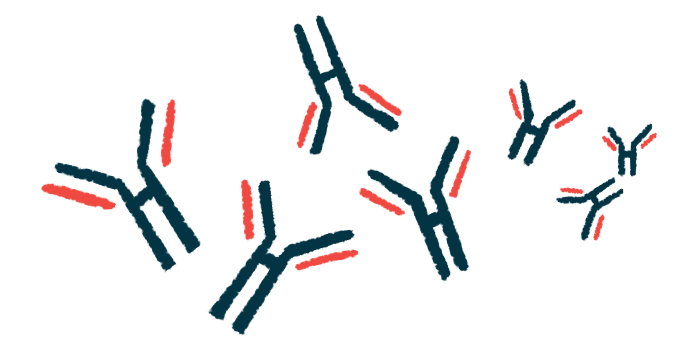Older age, steroid pulse therapy lead to low levels of helpful antibodies
Higher infection risk seen in AAV patients given methylprednisolone pulses

ANCA-associated vasculitis (AAV) patients who are older and taking pulses of methylprednisolone as an induction therapy are more likely to have a greater drop in protective IgG antibody levels during maintenance therapy with rituximab, raising a significant risk of severe infections, a study from France reports.
A lower antibody count before induction therapy also made a condition known as hypogammaglobulinemia — low levels of antibodies like IgG (immunoglobulin G), a type of gammaglobulin — more likely during rituximab maintenance treatment, the researchers noted.
The study, “Risk factors for hypogammaglobulinemia and association with relapse and severe infections in ANCA-associated vasculitis: A cohort study,” was published in the Journal of Autoimmunity.
Immunoglobulins like IgG are antibodies that protect against infection
AAV happens when self-reactive antibodies called ANCAs prompt immune cells called neutrophils to turn against the walls of blood vessels, causing them to become inflamed. This leads to a range of disease symptoms.
Rituximab, sold as Rituxan in the U.S. and Mabthera in Europe by Roche, with biosimilars available, is a medication that reduces the number of B-cells, a type of immune cell that produces antibodies, including those that are thought to drive AAV.
The therapy is approved both as an induction and maintenance therapy for granulomatosis with polyangiitis (GPA) and microscopic polyangiitis (MPA), the two most common types of AAV.
Given that rituximab can cause lower levels of antibodies, which also help in defending against harmful viruses and bacteria, the B-cell-depleting therapy can increase an infection risk in AAV patients.
However, “the [dynamics] of [rituximab-induced] hypogammaglobulinemia are not well described and might be influenced by several underlying factors,” the researchers wrote, adding that “correlations between gammaglobulin [IgG] levels and the risk of [disease] relapse and severe infections remain to be clarified.”
To identify such risk factors, researchers at centers in Paris and Angoulême looked at data covering 98 adults (63 women, 35 men) with AAV who received treatment between January 2010 and November 2022.
Patients were a median of 52 years old at the time of their AAV diagnosis, and most (86.7%) had GPA, while the remaining 13 (13.3%) had MPA. Little less than half (45.9%) had newly diagnosed disease, while 54.1% had relapsing disease.
All achieved complete remission after induction therapy with rituximab or cyclophosphamide, and received rituximab as maintenance treatment for at least two years.
Induction therapy consisted of rituximab in most cases (86.7%). For the remaining patients (31.6%), it involved pulses of methylprednisolone, a glucocorticoid, on top of rituximab or cyclophosphamide.
Methylprednisolone pulses tied to 5 times higher severe infection risk
Blood IgG levels were collected six months before induction therapy, at maintenance treatment’s start, and again every six months until patients experienced a relapse or follow-up stopped.
Median levels of these antibodies dropped by 25% between six months before induction therapy and the start of maintenance therapy, results showed. Using rituximab or cyclophosphamide as an induction therapy had no major influence on this drop.
After starting rituximab maintenance therapy, antibody levels remained generally stable, showing a 2.5% reduction six months later and a 4.4% drop after one year.
At the beginning of maintenance therapy, 26 patients (26.5%) had hypogammaglobulinemia, or IgG levels below 6 g/L, and six patients (6.1%) had severe hypogammaglobulinemia (levels below 4 g/L).
Nineteen patients (19.4%) had both hypogammaglobulinemia after induction and a greater than 25% decline in IgG levels between their induction and maintenance treatments.
Statistical analyses considering several potential influencing factors showed that IgG levels below 10 g/L before induction therapy significantly associated with a 13 times higher likelihood of hypogammaglobulinemia.
The use of methylprednisolone pulses also significantly linked to a nearly four times higher likelihood of hypogammaglobulinemia and a 4.5 higher chance of experiencing an IgG reduction of more than 25%.
Being older than 60, having IgG levels below 10 g/L before induction therapy, and receiving methylprednisolone pulses also were significant risk factors of both hypogammaglobulinemia and a greater than 25% IgG decline — increasing the odds by about four to six times.
“Older age, low gammaglobulin levels and pulses of methylprednisolone at induction are associated with greater gammaglobulin decline after induction,” the researchers wrote.
Over a median follow-up of 47 months (nearly four years), 24.3% of patients experienced a relapse, and 28.6% had at least one severe infection during rituximab maintenance therapy.
While hypogammaglobulinemia and/or an IgG decline greater than 25% did not significantly associate with the risk of relapse, having both of these factors was linked to a twice higher change of severe infection.
Pulses of methylprednisolone also significantly associated with a five times higher chance of a severe infection “independently of gammaglobulin levels,” the team wrote.
“While it is not associated with a lower risk of vasculitis relapse, gammaglobulin decline is associated with an increased risk of severe infections,” the researchers wrote.
“Our results may encourage practitioners to identify patients at high risk of hypogammaglobulinemia in whom pulses of methylprednisolone should be judiciously used,” they concluded.
All of this study’s eight researchers were involved in clinical trials of rituximab.







